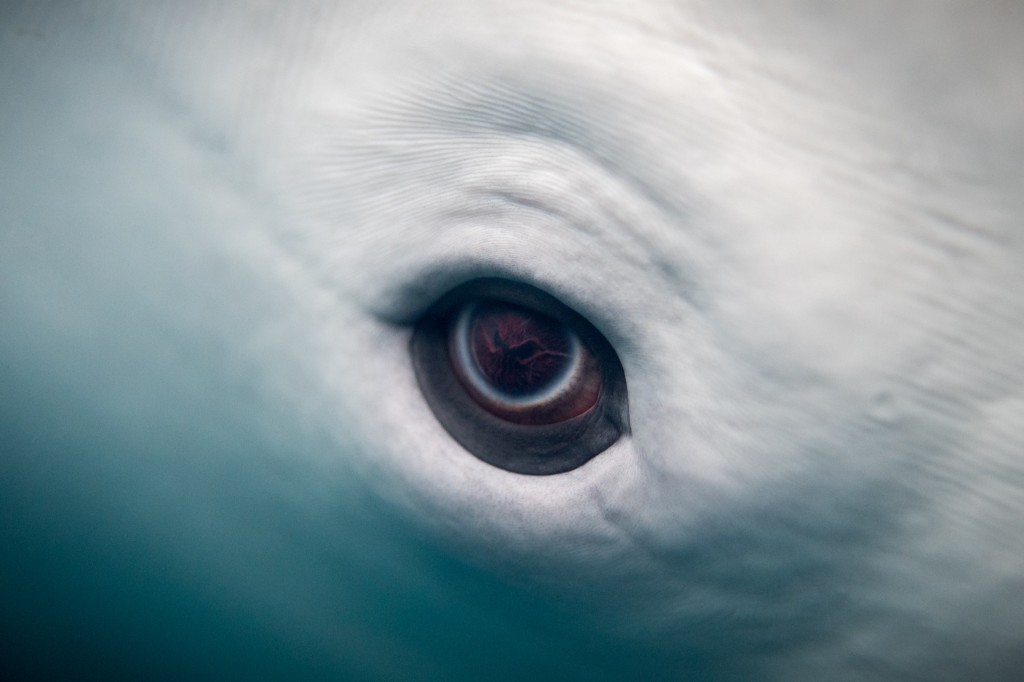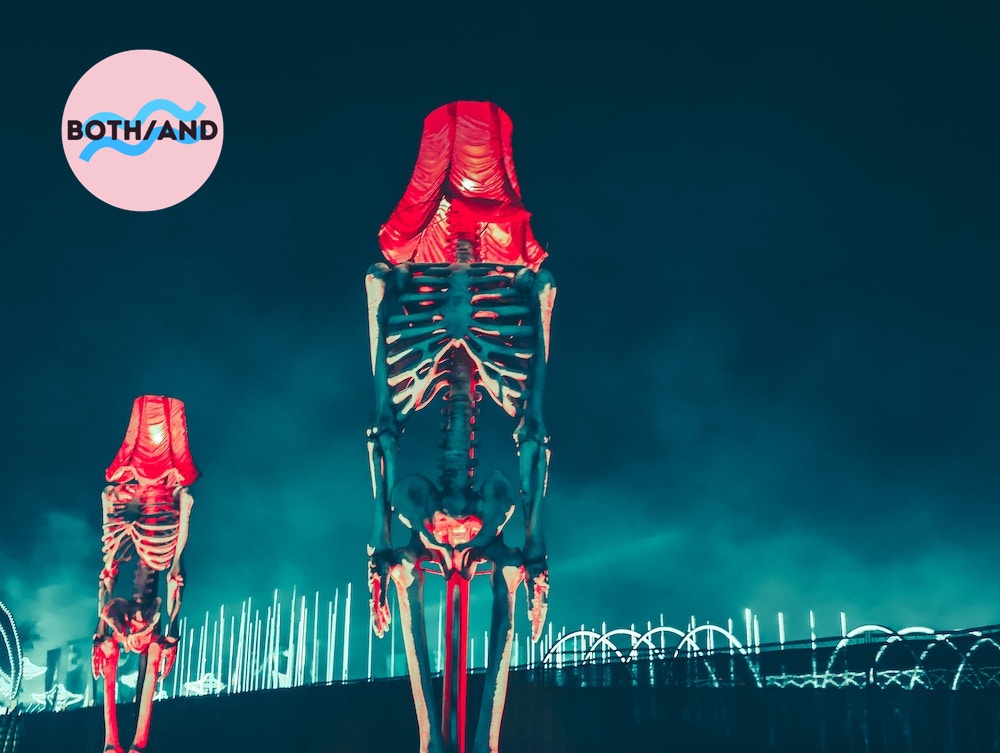Books & Culture
We Need More Non-Binary Characters Who Aren’t Aliens, Robots, or Monsters
Most characters who aren’t male or female also aren’t human. Where does that leave those of us who are?

There’s a running joke in NBC’s The Good Place about Janet, the neighborhood’s anthropomorphized operational mainframe. Every time one of the other characters calls her a “girl” or a “woman,” she cheerfully corrects them, “I’m not a girl.”
The point is that Janet is a manufactured database and not a person. But bound up in this idea is a more complicated one: that Janet, not being a human at all, is also specifically not a girl. She is a sophisticated form of artificial intelligence, and while she presents in a feminine manner she doesn’t identify as female — or even have a sense of binary gender identity. She’s a non-binary character on a major network sitcom whose gender identity, or lack thereof, does not define her — a feat which should be in and of itself a kind of revolution.
Where non-binary characters appear in literature and culture, they are more often than not robots, or aliens, or monsters.
The flip side, though, is also embodied in the joke: Janet isn’t a girl because she’s not a person. Where non-binary characters appear in literature and culture, they are more often than not robots, or aliens, or monsters. They are not so often, as I am, human beings.
I came out as non-binary in a series of stages, over the course of a number of years. It was a hard identity to put a name to, to come to understand. I’m still not completely out, and I tend to hide my gender in situations where I’ve been made to feel like it’s an inconvenience — with professors who make no space in their classrooms for considerations like pronouns, with family members for whom explaining the concept would fall on ultimately uncomprehending ears, with my housemates in the all-female campus housing in which I live.
No queer identity ever comes with a singular “coming out,” and every time I meet a new person I fall into a routine of social calculus to decide whether or not it’s worthwhile to explain my identity. Will I see this person again? Will they attack me, if I tell them? Will they respect my pronouns, if told? Will they invalidate my identity if I reveal it to them at a later date, or take offense that I didn’t tell them earlier? I have a body that is read as female, no matter what I do, and sometimes the process of explaining that I’m not a woman isn’t practical in the moment.
I don’t like that my social identity boils down to some kind of cost-benefit analysis, but society’s understanding — or lack thereof — of non-binary gender forces me to think of it that way. Social interactions are structured with this mental math at the forefront. When faced with someone new, people instinctually calculate the answer to a rote question which will influence almost everything about the way they will interact with this person: are they a boy or a girl?
There is no room, in this question, for the answer to be “no.”
The first time I realized I was non-binary, I was listening to a recording of Andrea Gibson’s poem “Swingset,” which opens with exactly this question: Are you a boy or a girl?
In the poem, Gibson never answers the question: they can’t, or perhaps they don’t need to. The normalization of their non-binary gender, the understanding that there is a third answer — a non-answer, in its own way — to this question, revolutionized me.
There is a recent trend in speculative fiction towards the inclusion of characters with non-binary genders, or characters who use non-binary pronouns (they/them/their, xe/xem/xyr, etc). Every time I see a singular they in one of the science fiction or fantasy novels I’ve picked up to read in my vanishingly small spare time, my heart skips a beat in joy and disbelief.
And yet, nearly every time a character in speculative fiction uses non-binary pronouns, it is also a signifier of something other than just gender; it is a signal to the reader that there is something other about the character in question, something which sets them apart from the other characters, and from the reader, too. It is a shortcut to remind the reader that, whoever this character is, they are emphatically not human.
It is a shortcut to remind the reader that, whoever this character is, they are emphatically not human.
For example: in Victoria Schwab’s Our Dark Duet (2017), the second book in her Monsters of Verity series, Schwab introduces a character who uses they/them pronouns. The character, Soro, is a Sunai — a monster of vengeance that consumes the souls of criminals. Their non-binary gender does not go unremarked upon in the book, which might normalize it the way any other character’s gender is unremarkable. Instead, this happens:
[When] he’d worked up the courage to ask whether Soro considered themself male or female, [they] had stared at him for a long moment before answering.
“I’m a Sunai.”
There are no non-binary humans in Our Dark Duet.
This scene should be significant — here, in a novel that isn’t about gender, a character is calling attention to the aching lacuna left by the binary question, “are you a boy or a girl?” They are finding an alternative answer. When Soro answers, I’m a Sunai, they are finding a new way to answer the question.
I’ve answered the question this way, too. A young child at my place of work once asked me: are you a boy or a girl? I panicked and answered: I’m a librarian. Can I help you find something?
But Soro’s answer actually becomes significant for a different reason. Their answer, I’m a Sunai, emphasizes above all else that which makes them inhuman, their monstrous identity. Because the other characters in Our Dark Duet are decidedly and unremarkably delineated as either male or female, Soro’s gender identity — or, more accurately, their refusal of gender — becomes a feature of their monstrosity. The answer comes not from a lack of identification with “male” or “female,” but from a lack of identification with humanity as a whole. It becomes synonymous with being an Other, just another way they are unfathomably different from those around them.
The answer comes not from a lack of identification with ‘male’ or ‘female,’ but from a lack of identification with humanity as a whole.
Our Dark Duet isn’t the only work of speculative fiction which does this. In fact, unlike in the lived experience of the non-binary people they represent, in speculative fiction characters who are neither a boy nor a girl are almost always something else. They are almost always something inhuman.
In Becky Chambers’ novel The Long Way to a Small, Angry Planet (2014) there is a genderfluid alien species known as the Aandrisk, who cyclically fluctuate among three genders: a male-aligned gender, a female-aligned gender, and a neutral gender identified with neo-pronouns.
There are, also, no notable genderfluid, non-binary, or transgender human characters in the novel.
The sequel to Planet — A Closed and Common Orbit (2016) — tells the story of an artificial intelligence named Sidra, who struggles with fitting into a body that does not fit her, and searches for ways and means of making that body into a place in which she can feel at home. Because of Sidra’s struggle, themes of embodiment run throughout the novel, and each character struggles with it in one way or another. An Aandrisk character named Tak plays a major role, with his/xyr/her gender fluidity never underplayed but treated as absolutely normal, which seems to cement the themes of gender identity squarely at the forefront of the novel. His/xyr/her ability to change his/xyr/her body in accordance with the gender-of-the-day is something Sidra envies.
And yet: it is only an alien character who deals openly with gender identity.
Tak and Sidra are joined by two human characters: Pepper, who was cloned to work in a manufacturing plant and escaped at a young age; and Blue, who was disowned by his wealthy ruling-class family for his persistent lisp. Every character in Orbit struggles, in their own way, with turning their body into a habitable home. To parallel Sidra’s narrative, as she struggles with the discomfort of not fitting into the body she was given, it would have been more than fitting for either Pepper or Blue to be non-binary or transgender. Blue, in particular, has a veiled past that isn’t revealed until late in the novel; until I reached the point where I realized that it was for his speech impediment that his family disowned him, I was certain he was trans.
But when only an alien’s relationship with their body involves a deviation from concepts of binary gender, the exclusion says more than the inclusion does.
It feels lazy, in a way. As if an author is checking off a diversity box for “character uses alternate pronouns,” but can’t be bothered to stretch their mind enough to imagine an actual human who might identify that way.
It feels lazy, and it feels — quite literally — alienating.
Often, like in the case of Soro or Janet, non-binary identity becomes a specific indicator that a character is not human, a distinct marker that sets them apart from humanity where their appearance might not. Other times, as with Tak and the Aandrisk, non-binary identity is meant to signify just how different — how alien — another culture is to humans. Non-binary identity becomes a shorthand for whatever it is that sets a character or group of characters apart from humans.
The problem here is that the non-binary people like me who want to see themselves represented and validated in the fiction they read, who might benefit most from seeing a character with alternate pronouns in their escapist media — are human. And most of the time, we’re faced with a daily barrage of people questioning the legitimacy of our gender identity.
When the only non-binary characters in media are aliens, robots, and monsters, we tacitly assert that the non-binary people in our lives are unnatural.
It doesn’t help anyone to say that aliens, robots, and monsters may have non-binary identities, but to imply by exclusion that humans do not.
When the only non-binary characters in media are aliens, robots, and monsters, we tacitly assert that the non-binary people in our lives are unnatural, that there is something inherently inhuman about their existence.
Gibson’s poem “Swingset” is, among so many other things, about the experience of being human. Their kindergarten students, wide-eyed and curious, batter them with a litany of questions which always ends with the innocent inquiry: Can I have a push on the swing? — the only answer provided to the unanswerable question presented in the poem’s first line.
The poem, as I replayed the video obsessively for weeks when I was seventeen, showed me a reality in which I did not have to be a boy or a girl, in which I could be something else and still be myself.
“Swingset” meant something to me, in my teenage struggle with my gender identity, because I could see myself in it. The non-answer to the unanswerable question gave me permission to accept that my gender was allowed to be unanswerable, too.
When this question is answered, and the answer is, “I’m a monster,” or “I’m an alien,” that permission gets lost in the shuffle.
There is speculative fiction that gets it right sometimes. But I can count on one hand the stories I have found lately that include gender non-conforming characters who are humans.
The ones that do, for me, are revolutionary.
Take, for instance, the podcast Friends at the Table. Their science fiction series COUNTER/weight includes, yes, robot characters who use they/them pronouns, and yes, an entire nearly-human alien race whose concept of gender is completely dissimilar from our own. But it also includes several non-binary human characters, such as the genius roboticist Cene Sixheart, and the Divine Candidate Kobus.
The message this sends is different: it shows us a future where humanity has eclipsed its obsession with binary concepts of gender, where non-binary gender is as much of a norm for humanity as it might be for an alien species that never developed the concepts of “male” and “female” to begin with. It shows that there is nothing inherently alien, monstrous, or unnatural — “inhuman” — about an identity that doesn’t fall in line with the gender binary.
There is nothing inherently inhuman about an identity that doesn’t fall in line with the gender binary.
It shows, in the same way that “Swingset” does, that non-binary people are just as human as anyone else. It erases the equation between non-binary and alien, blurs the strict separation that aligns binary gender with humanity and non-binary gender with everything else. It gives us space to see ourselves, whoever we may be, exactly as we are.
It is vital to be conscious of the dangerous patterns that can emerge from a kind of representation that isn’t aware of its own history, or the implications it makes when it is not written with care. Otherwise, we end up reaffirming a system which continues to alienate non-binary gender and those who identify with it.
I love non-binary monsters. I love non-binary aliens, and non-binary robots. I love space operas and paranormal romances and anything “inhuman” that I come across. But sometimes there are days when — exhausted by the social calculus of navigating a world that does not make space for me, that does not take me for what I am — I need my fiction to remind me that I am human, too.








